Research on design trends of intelligent cockpits: explore 3D, integrated interaction.
In 2022, multiple automakers have released new concept car models, showing their vision and understanding of future smart cars and providing innovative ideas for the development of future intelligent cockpits. For example, in early 2022, Mercedes-Benz unveiled ISION EQXX, a new concept car that displays a new interior cockpit concept. As well as lightweight, sustainable materials, this car packs a 47.5-inch completely seamless ultrathin one-piece display (with an 8K resolution and the backlight consisting of more than 3000 local dimming zones) and introduces game engines and fully optimized user interfaces. As concerns HMI design, the system mounted on the car is structured along neuromorphic principles and adopts an intuitive working method that mimics the workings of the human brain.
In November 2022, Yanfeng introduced XiM23, a new concept car that interprets the company’s understanding of future luxury cockpits: a through-type extended curved display (dashboard + 2 center console screens) that can be hidden and lifted + a lifting multi-functional Phygital controller (display + knob, with gesture control and interactive smart surface features). In terms of driving modes, this car (with L2 driving assistance functions) offers two default manual driving modes, Calm and Rich, and the L4 autonomous driving mode.
In addition to concept cars, there are also a number of innovative models launched on market in 2022. In particular, the cars from emerging carmakers, such as Li Auto L9, AITO M7, Avatr 11 and Jidu ROBO-01 Lunar Edition, bear new products and technologies including human-computer interaction, displays, seats, sound effects, ambient lights, and smart surfaces. New technologies, new scenarios and new modes are springing up.
Li Auto’s second model, L9, was rolled out in June 2022. With interiors laid out with new technological thinking, this car enables five-screen three-dimensional space interaction. The second-row central screen cancels the conventional instrument panel design, and the information content of the dashboard is distributed to the small-sized display in the center of the steering wheel, and HUD, offering intuitive, simple and direct experience.
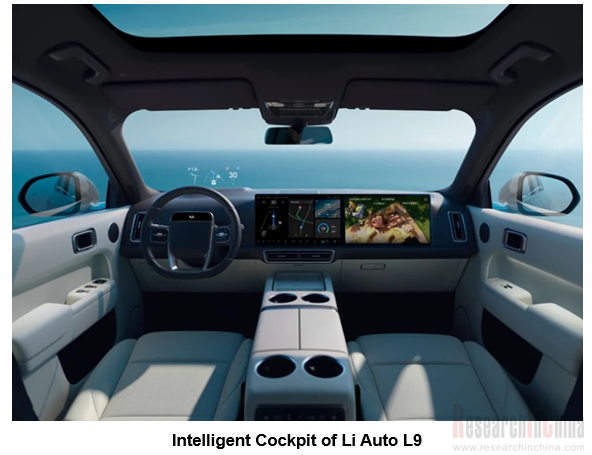
Jidu ROBO-01 Lunar Edition released in November 2022 packs a 35.6-inch integrated display with a high color gamut of 95% NTSC and an ultrahigh contrast ratio of 10,000:1, as well as a 3D immersive cockpit with voice and user emotion recognition capabilities. This car can interact with the outside world about its own state and emotions. Its robotized front face design integrates interactive AI pixel headlights and an AI voice interaction system with a high recognition rate. The external voice recognition function enables the natural communication between people, vehicle and environment.
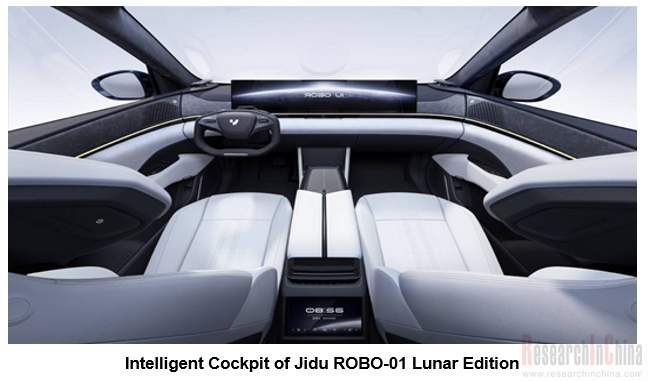
The intelligent cockpit is a space that provides users with human, vehicle and environment needs and information interaction. The intelligent vehicle consumption upgrade favors the interaction mode switching from the conventional flat, relatively independent interaction mode to the three-dimensional integrated interaction mode. Continuous efforts will be made to explore the demand for emotional interaction and human-vehicle “resonance”. Moreover users have ever greater demand for personalized car services and emotional interaction. The development of intelligent cockpits lays more stress on personalized space, and friendly interaction and services.
3D Unreal Engine is applied, and human-machine interface offers more three-dimensional, intuitive and convenient interaction.
As an open real-time 3D creation platform, Unreal Engine has found broad application in automotive design and engineering, especially in human-computer interaction. An increasing number of automakers have partaken in the joint development with Unreal Engine. The likes of Mercedes-Benz, Nissan, GM, SAIC IM Motors, and Xpeng Motors all use Unreal Engine in their intelligent cockpits to make the interaction more intuitive and three-dimensional and improve cockpit immersive experience and driving safety.
IM L7, launched on market in 2022, bears a 3D user interface (UI) co-created by Banma Zhixing and Unity. It supports multi-screen streaming and cross-screen display of 3D applications, 3D visualization of the car control interface, and 3D particle dynamic effects on the air-conditioner interface, intelligent driving HD map display, and immersive games that combine vehicle information and multi-mode interaction.
Xpeng G9, marketed in 2022, carries 3D UI for human-computer interaction. Developed with Unity 3D rendering engine, this feature enables control on suspension, air conditioners, windows, trunk and ambient lights via the 3D car model touch screen in the car control display. Moreover the new interaction system can render 3D maps in real time to improve navigation accuracy, and also allows users to control car details such as windows and suspension through the large display, a visible way.
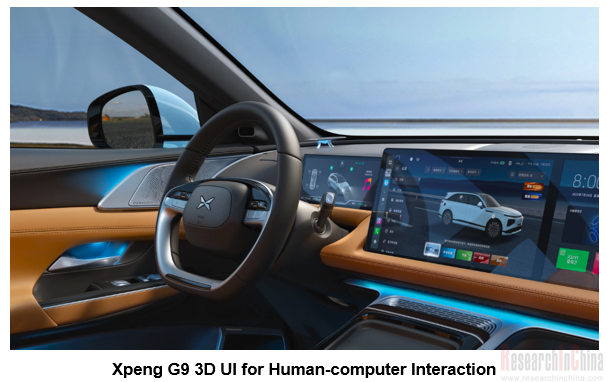
The intelligent cockpit design of the new 7th-generation Ford Mustang launched in 2022 is inspired by fighter jets. The car is equipped with two displays developed with the 3D Unreal Engine platform, and supports customizable functions such as animation design and new driving mode display interface.
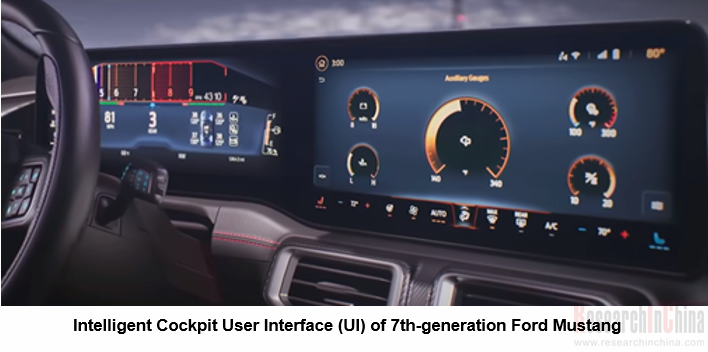
The future Unreal Engine is likely to become a general-purpose next-generation engine that empowers the automotive industry, and provides creation teams with efficient cooperative productivity and better interaction experience to bring the creativity of designers into full play.
The cockpit scenario mode design tends to be personalized, user-defined and all-scenario integrated.
Scenario mode is a major development trend of future intelligent cockpits. There are mainly two types of modes: interior scenario, and interior and exterior combined scenario. In terms of interior scenario mode, currently new car models enable simple scenario interaction through intelligent configurations such as voice, ambient lights, and multi-functional seats. For instance, when the nap mode available in most car models is turned on, the driver's seat will automatically "lay flat", the air conditioner will automatically open and the lights, windows, sunroof, and visors will all be closed; after the timing ends, there will be a music alarm, and the seat will return to its original state after clicking the end.
In the trend for software-defined vehicles and service-oriented architecture (SOA) design, this mode supports editing of intelligent scenarios on the intelligent cockpit screens. Many new car functions are not always developed from scratch, but as for a number of simple functions based on intelligent scenario combination, the SOA software architecture allows OEMs to abstract each minimum function into atomic services, and freely combine them into a more intelligent scenario-based function by way of service calling. The trend for user-defined, personalized intelligent cockpit scenarios becomes ever more obvious.
IM L7 that features IMOS and Onehit scenario-based experience design allows car owners to combine vehicle control items into their own exclusive modes. For example, it enables one-button definition of the female owner welcoming and built-in nap mode that supports one-button control on seats, air conditioner and fragrance, and display of the teamLab-customized flowering dynamic effect on the screen, so as to offer immersive relaxation experience, while in the pet mode, the system automatically adjusts the air conditioner ventilation to create a comfortable environment for the pet. Furthermore, the ISC at the front and rear of the car can express the state of the pet in the car in a warmly manner, so as not to worry passersby.
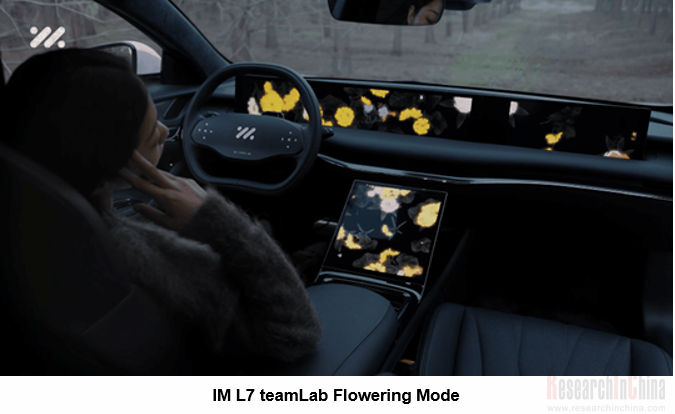
In addition, as new technologies are adopted and autonomous driving matures, in the future cockpit scenarios will evolve from single scenarios to multi-scenario integration to meet user needs. In different scenarios, the changing interior space facilitates the expansion of the interior modes, which can be converted according to different scenarios of driving, rest, and office. When the user needs a rest, the steering wheel can be retracted, and the seat can be folded down or even become a bed; when the user needs to communicate with other occupants or entertain, the seat can be rotated; when the user needs to watch a movie, the entire window or windshield can turn into a large display.
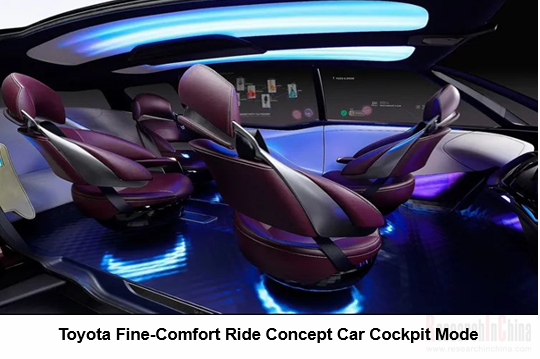
The vehicle cockpit game market is flourishing, and the market demand is waiting to be unleashed.
As intelligent driving advances, the entertainment functions of intelligent cockpits are being developed. In recent years, multiple automakers like Tesla, Audi, Mercedes-Benz, GAC, Great Wall Motor, BYD and Li Auto have begun to deploy vehicle games. Among them, Tesla is a pioneer. In June 2019, Tesla introduced the Arcade Game Platform in which users can access a variety of Atari games via the center console screen, and then the real-time game OTA updates are available. In June 2021, Tesla demonstrated the 3A masterpiece game "Cyberpunk 2077" at the Model S Plaid Launch. In July 2022, Tesla announced that it would integrate the Steam game platform into the car, allowing users to experience a mass of Steam games in the car.
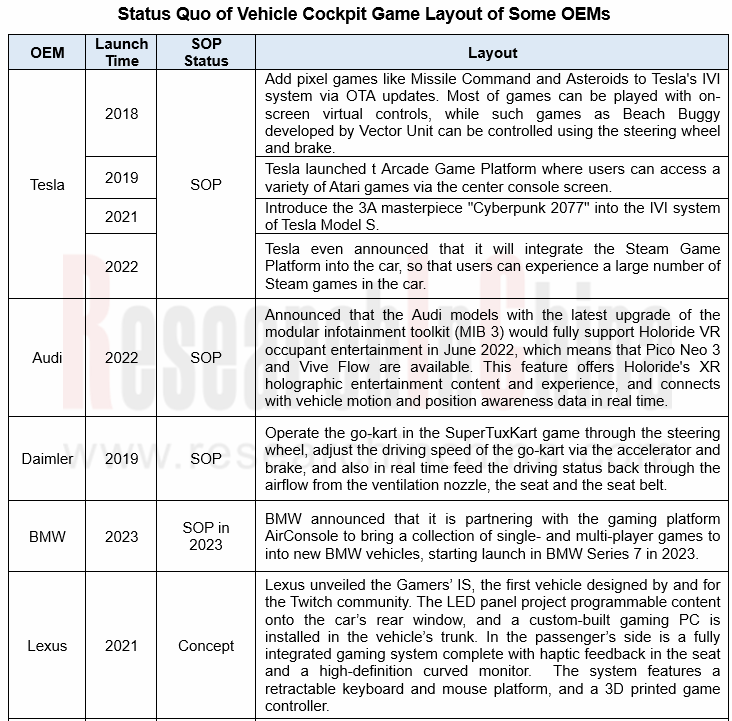
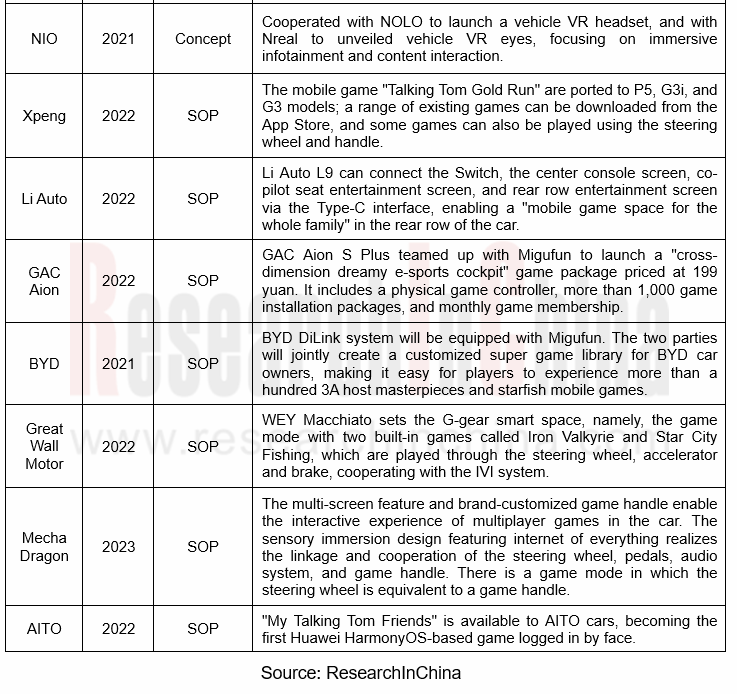
The entertainment system of Li Auto L9, a new model launched in 2022, supports connection and mirroring of Switch and other game console devices, turning the car into a "mobile game space for the whole family" and bringing consumers better ride experience. The 220V power supply of Li Auto L9, equipped with the HDMI-Type-C adapter cable, allows users to play all kinds of game consoles and 3A masterpieces in the car.
At present, the demand for vehicle games has yet to be unleashed, but when the maturing autonomous driving technologies enable hands-free driving, the demand for vehicle games will usher in a boom period. It is expected that the penetration rate of vehicle games will be higher than 20% after L4 autonomous driving comes into service.
In the future, the maturing intelligent and autonomous driving technologies will help to make vehicles large mobile intelligent terminals; vehicle games will trend to provide more spatial and immersive experience; the forms and types of games will also become more diversified.
China Automotive Multimodal Interaction Development Research Report, 2023
China Automotive Multimodal Interaction Development Research Report, 2023 released by ResearchInChina combs through the interaction modes of mainstream cockpits, the application of interaction modes i...
Automotive Smart Surface Research Report, 2023
Market status: vehicle models with smart surfaces boom in 2023
From 2018 to 2023, there were an increasing number of models equipped with smart surfaces, up to 52,000 units in 2022 and 256,000 units ...
Passenger Car Intelligent Steering Industry Report, 2023
Passenger Car Intelligent Steering Industry Report, 2023 released by ResearchInChina combs through and studies the status quo of passenger car intelligent steering and the product layout of OEMs, supp...
Automotive High-precision Positioning Research Report, 2023-2024
Autonomous driving is rapidly advancing from highway NOA to urban NOA, and poses ever higher technical requirements for high-precision positioning, highlighting the following:
1. Higher accuracy: urb...
New Energy Vehicle Thermal Management System Research Report, 2023
Thermal management system research: the mass production of CO? heat pumps, integrated controllers and other innovative products accelerates
Thermal management of new energy vehicles coordinates the c...
Commercial Vehicle Intelligent Chassis Industry Report, 2023
Commercial Vehicle Intelligent Chassis Industry Report, 2023, released by ResearchInChina, combs through and researches status quo and related product layout of OEMs and suppliers, and predicts future...
Chinese Independent OEMs’ ADAS and Autonomous Driving Report, 2023
1. Wide adoption of NOA begins, and local brands grab market share.
According to ResearchInChina, from January to August 2023, joint venture brands accounted for 3.0% of installations of L2.5 and hi...
Passenger Car Radar Industry, 2022-2023
Passenger Car Radar Industry Research in 2023:?In 2023, over 20 million radars were installed, a year-on-year jump of 35%;?Driven by multiple factors such as driving-parking integration, NOA and L3, 5...
Automotive Audio System Industry Report, 2023
Technology development: personalized sound field technology iteration accelerates
From automotive radio to “host + amplifier + speaker + AVAS” mode, automotive audio system has passed through several...
China Intelligent Door Market Research Report, 2023
China Intelligent Door Market Research Report, 2023 released by ResearchInChina analyzes and studies the features, market status, OEMs’ layout, suppliers’ layout, and development trends of intelligent...
Automotive Infrared Night Vision System Research Report, 2023
According to the data from ResearchInChina, during 2022-2023, the installations of NVS (night vision system) in new passenger cars in China went up at first and then down. From January to July 2022, t...
New Energy Vehicle Electric Drive and Power Domain Industry Report, 2023
Electric drive and power domain research: electric drive assembly evolves to integration and domain control
To follow the development trend for electrified and lightweight vehicles, new energy vehic...
Automotive Software Business Models and Suppliers’ Layout Research Report, 2023
From the layout of automotive software products and solutions, it can be seen that intelligent vehicle software business models include IP, solutions and technical services, which are mainly charged i...
Automotive LiDAR Industry Report, 2023
In August 2021, Waymo discontinued its commercial LiDAR business.
In October 2022, Ibeo declared bankruptcy; in November, two listed companies, Velodyne and Ouster, confirmed their merger; and in Dec...
Automotive Power Supply (OBC+DC/DC+PDU) and Integrated Circuits (IC) Industry Report, 2023
Automotive power supply and IC: Chinese chips are promising in the evolution from physical integration to system integration
As the core component of a new energy vehicle, automotive power supply is ...
OEMs’ Model Planning Research Report, 2023-2025
OEMs’ Model Planning Research Report, 2023-2025, released by ResearchInChina, combs through model planning and features of Chinese independent brands, emerging carmakers, and joint venture brands in t...
Leading Foreign OEMs’ADAS and Autonomous Driving Report, 2023
Global automakers evolve to software-defined vehicles by upgrading EEAs.
Centralized electronic/electrical architectures (EEA) act as the hardware foundation to realize software-defined vehicles. At ...
Automotive AI Algorithm and Foundation Model Application Research Report, 2023
Large AI model research: NOA and foundation model facilitate a disruption in the ADAS industry.
Recently some events upset OEMs and small- and medium-sized ADAS companies, as the autonomous driving i...